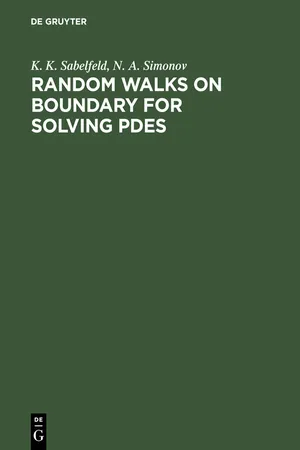
This is a test
- 141 pages
- English
- PDF
- Available on iOS & Android
eBook - PDF
Random Walks on Boundary for Solving PDEs
Book details
Table of contents
Citations
Frequently asked questions
At the moment all of our mobile-responsive ePub books are available to download via the app. Most of our PDFs are also available to download and we're working on making the final remaining ones downloadable now. Learn more here.
Both plans give you full access to the library and all of Perlego’s features. The only differences are the price and subscription period: With the annual plan you’ll save around 30% compared to 12 months on the monthly plan.
We are an online textbook subscription service, where you can get access to an entire online library for less than the price of a single book per month. With over 1 million books across 1000+ topics, we’ve got you covered! Learn more here.
Look out for the read-aloud symbol on your next book to see if you can listen to it. The read-aloud tool reads text aloud for you, highlighting the text as it is being read. You can pause it, speed it up and slow it down. Learn more here.
Yes, you can access Random Walks on Boundary for Solving PDEs by Karl K. Sabelfeld, Nikolai A. Simonov in PDF and/or ePUB format, as well as other popular books in Mathematics & Differential Equations. We have over one million books available in our catalogue for you to explore.
Information
Table of contents
- 1. Introduction
- 2. Random walk algorithms for solving integral equations
- 2.1. Conventional Monte Carlo scheme
- 2.2. Biased estimators
- 2.3. Linear-fractional transformations and relations to iterative processes
- 2.4. Asymptotically unbiased estimators based on singular approximation of the kernel
- 2.5. Integral equation of the first kind
- 3. Random Walk on Boundary algorithms for solving the Laplace equation
- 3.1. Newton potentials and boundary integral equations of the electrostatics
- 3.2. The interior Dirichlet problem and isotropic Random Walk on Boundary process
- 3.3. Solution of the Neumann problem
- 3.4. Random estimators for the exterior Dirichlet problem
- 3.5. Third boundary value problem and alternative methods of solving the Dirichlet problem
- 3.6. Inhomogeneous problems
- 3.7. Calculation of the derivatives near the boundary
- 3.8. Normal derivative of a double layer potential
- 4. Walk on Boundary algorithms for the heat equation
- 4.1. Heat potentials and Volterra boundary integral equations
- 4.2. Nonstationary Walk on Boundary process
- 4.3. The Dirichlet problem
- 4.4. The Neumann problem
- 4.5. Third boundary value problem
- 4.6. Unbiasedness and variance of the Walk on Boundary algorithms
- 4.7. The cost of the Walk on Boundary algorithms
- 4.8. Inhomogeneous heat equation
- 4.9. Calculation of derivatives on the boundary
- 5. Spatial problems of elasticity
- 5.1. Elastopotentials and systems of boundary integral equations of the elasticity theory
- 5.2. First boundary value problem and estimators for singular integrals
- 5.3. Other boundary value problems for the Lame equations and regular integral equations
- 6. Variants of the Random Walk on Boundary for solving the stationary potential problems
- 6.1. The Robin problem and the ergodic theorem
- 6.2. Stationary diffusion equation with absorption
- 6.3. Stabilization method
- 6.4. Multiply connected domains
- 7. Random Walk on Boundary in nonlinear problems
- 7.1. Nonlinear Poisson equation
- 7.2. Boundary value problem for the Navier-Stokes equation
- Bibliography